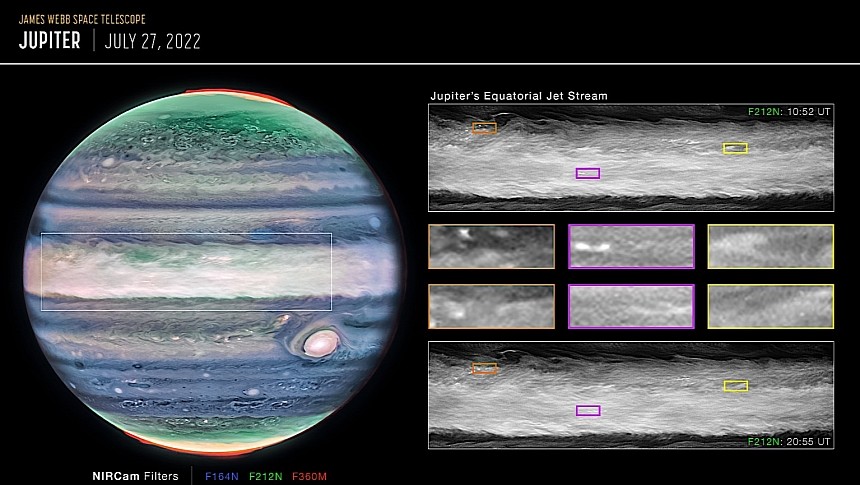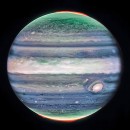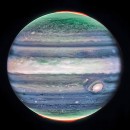Our species likes to think that, at least when it comes to the things that really matter, we pretty much know all there is to know about the planets in our solar system. But a recently published discovery of the James Webb Space Telescope (JWST) makes it painfully clear that's far from the truth.
The discovery has to do with Jupiter, a place we first spotted by telescope in 1610. That's the largest planet in our solar system, a turbulent gas giant so big that just one of the storms ravaging its atmosphere, the one we know as the Great Red Spot, is larger than Earth itself.
The place has been an object of study for astronomers since humans learned what the lights in the night sky are and how to look at them. We've learned, in time, that Jupiter is located 5.2 astronomical units from the Sun (meaning more than five times further from our star than Earth); that a single day there lasts ten years, and a year there is 12 years here; that it has at least 95 moons, but no solid surface of its own.
We know the gas giant would kill life as we know it in an instant thanks to clouds of ammonia, hydrogen and helium that move thanks to a weather system that's been under our scrutiny for decades.
And yet, there are probably so many things we don't know about the planet. One of them, the presence of a "never-before-seen feature" was just made public by people looking at James Webb data.
The space telescope was pointed at Jupiter in the summer of last year, and its potent hardware managed to reveal that features humans only saw until now as blurred hazes are in fact jet streams.
One of them, floating about 25 miles (40 km) above the clouds, spans a massive width of 3,000 miles (4,800 km) over the planet's equator. In this region, there are winds blowing at some 320 mph (515 kph), two times faster than what a category 5 hurricane is capable of here on Earth.
"This is something that totally surprised us," said in a statement Ricardo Hueso from the University of the Basque Country in Bilbao, Spain. "What we have always seen as blurred hazes in Jupiter's atmosphere now appear as crisp features that we can track along with the planet's fast rotation."
Hueso and his team published their findings in Nature this week, but says that additional observations need to be made to see whether the jet's speed and altitude change over time. Expectations are they will, if the jet plays along with the known rules of the Jovian weather system.
In the meantime, Webb is continuing to look at stars and planets in ways never possible before. It's a bit sad though that it takes so long for a discovery it makes to be spotted by humans. But you can't really help that, given the incredible large troves of information the telescope regularly sends back.
The place has been an object of study for astronomers since humans learned what the lights in the night sky are and how to look at them. We've learned, in time, that Jupiter is located 5.2 astronomical units from the Sun (meaning more than five times further from our star than Earth); that a single day there lasts ten years, and a year there is 12 years here; that it has at least 95 moons, but no solid surface of its own.
We know the gas giant would kill life as we know it in an instant thanks to clouds of ammonia, hydrogen and helium that move thanks to a weather system that's been under our scrutiny for decades.
And yet, there are probably so many things we don't know about the planet. One of them, the presence of a "never-before-seen feature" was just made public by people looking at James Webb data.
The space telescope was pointed at Jupiter in the summer of last year, and its potent hardware managed to reveal that features humans only saw until now as blurred hazes are in fact jet streams.
One of them, floating about 25 miles (40 km) above the clouds, spans a massive width of 3,000 miles (4,800 km) over the planet's equator. In this region, there are winds blowing at some 320 mph (515 kph), two times faster than what a category 5 hurricane is capable of here on Earth.
"This is something that totally surprised us," said in a statement Ricardo Hueso from the University of the Basque Country in Bilbao, Spain. "What we have always seen as blurred hazes in Jupiter's atmosphere now appear as crisp features that we can track along with the planet's fast rotation."
Hueso and his team published their findings in Nature this week, but says that additional observations need to be made to see whether the jet's speed and altitude change over time. Expectations are they will, if the jet plays along with the known rules of the Jovian weather system.
In the meantime, Webb is continuing to look at stars and planets in ways never possible before. It's a bit sad though that it takes so long for a discovery it makes to be spotted by humans. But you can't really help that, given the incredible large troves of information the telescope regularly sends back.





